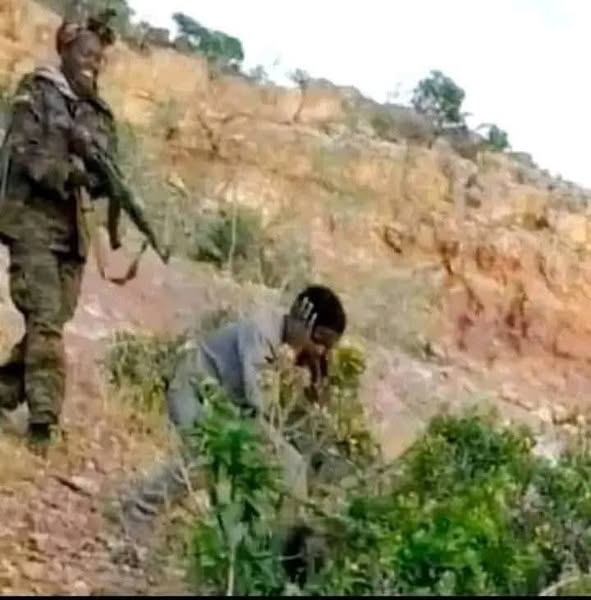Mekelle፡Telaviv, Nairobi, Pretoria, London, (Tigray Herald)
strategic political and diplomatic analysis document on the Eritrean Diaspora Blue Revolution,with particular focus on the Birged Nhamedu movement and its implications for regime change in Eritrea and a renewed political order in the Horn of Africa.
From Blue Revolution to Strategic Liberation: The Rise of Birged Nhamedu and the Endgame of Eritrea’s Brutal Regime
Prepared by Horn of Africa Geopolitical Review (HAGR) and Tigray Herald Editorial Teams,In collaboration with leading regional and international political, diplomatic, and security experts
Executive Summary
The winds of change are blowing across the Red Sea coast and into the heart of Asmara. For over three decades, the Eritrean people have endured an unimaginable legacy of brutality, isolation, and state repression under the tyrannical rule of President Isaias Afwerki and his People’s Front for Democracy and Justice (PFDJ). Today, this era is nearing its historical end.
Spearheading this irreversible momentum is the Birged Nhamedu Movement, a globally
coordinated diaspora-led force of young Eritrean former soldiers, intellectuals, and activists unified in their call: “Never Again: The End of the Isaias Era.”
This strategic document analyzes the political, diplomatic, and security implications of this rising Eritrean liberation movement. It situates Birged Nhamedu within a broader Horn of Africa transformation framework, highlighting how the new Eritrean generation is positioning itself as a strategic ally for regional peace and post-authoritarian reconstruction—especially with emerging movements in Tigray.
- Historical Context: 34 Years of Tyranny
Since Eritrea’s formal independence in 1993, Isaias Afwerki has ruled with an iron fist,
eliminating all opposition, shutting down independent media, imprisoning thousands without trial, and maintaining an indefinite national service that has turned the country into a “North Korea of Africa.” Over 500,000 Eritreans—nearly 10% of the population—have fled the country.
Families are torn apart, dissent is criminalized, and the regime survives solely through violence and foreign mercenary politics. The once-celebrated independence hero has become the continent’s most reviled autocrat. His obsession with power has also made Eritrea a pariah state, diplomatically isolated and economically hollowed.
- The Emergence of Birged Nhamedu: Forces of Hope and Strategic Change
The Birged Nhamedu movement—translated as “Our Generation’s War” or “Our Time of
Revolution”—represents a tectonic political shift. It is a youth-led, internationally coordinated liberation effort grounded in democratic principles, transitional justice, regional reconciliation, and post-conflict reconstruction. Originating from European and North American protests, its ideological base is now rooted in Ethiopia, where exiled Eritreans are organizing with regional actors.
Key Features:
Composed of ex-military conscripts, political dissidents, and youth activists with firsthand
experience of the regime’s brutality.
Operating across Europe, North America, Sudan, and Ethiopia with growing political recognition. Formally aligned with pro-democracy and reformist actors in the Horn of Africa. Strategically engaging Western diplomats, UN institutions, and African Union officials. Capable of forming an inclusive transitional council for post-Isaias Eritrea.
- The End of the Unholy Alliance: TPLF–PFDJ Death Pact
The once-covert political and military alliance between the TPLF splinter group led by
Debretsion Gebremichael and the PFDJ regime of Isaias Afwerki was a desperate convergence of two failed authoritarian legacies. What began as a temporary tactical alignment during the early phase of the Tigray conflict quickly revealed itself as a “Death Pact of Dictatorship.”
PFDJ’s military invasion of Tigray in 2020 with Ethiopian federal forces marks one of the darkest chapters in Eritrean history TPLF’s criminal silence and complicity in the face of these atrocities discredited its leadership
permanently. Both regimes, clinging to the past, have now been overtaken by newer generations demanding change.
This alliance is now discredited regionally and globally, creating a power vacuum ripe for
reformist movements like Birged Nhamedu in Eritrea and Getachew Reda’s civilian government in Tigray to establish a new political order.
- Strategic Diplomatic Dynamics: Birged Nhamedu as a Regional Game Changer
Diplomatic Opportunities:
Recognition by EU, AU, and UN bodies as the legitimate opposition voice representing the
Eritrean people. Strategic alliance with Tigray’s civilian and military reformists, especially Gen. Tsadkan Gebretensae’s group. Moral and political support from the United States, particularly Congress members pushing for sanctions on the PFDJ.
Back-channel diplomatic engagement with Gulf states, especially UAE and Qatar, for
transitional economic and political support.
Security Dimensions:
Forming a post-Isaias transitional security force, with support from exiled Eritrean soldiers. Establishing a joint Tigrayan-Eritrean stability zone along the border to prevent chaos and foreign interference.Advocating for a UN-supervised disarmament and transitional justice program.
- Toward a Strategic Alliance: Birged Nhamedu and Tigray’s New Generation
What once divided Tigrayans and Eritreans—borders, wars, propaganda—is being erased by a shared desire for justice, peace, and dignity. A genuine alliance is now emerging between:
The younger TDF generation who fought to survive genocidal aggression and seek a
democratic Tigray The Birged Nhamedu fighters who demand an end to Eritrean tyranny and a dignified return home. Together, these two movements can co-lead a Red Sea Security and Reconstruction Alliance rooted in:
Post-war reconciliation and truth commissions.
Demilitarized border zones and cross-border peace forums. Economic integration plans and mineral diplomacy partnerships.
- Recognition and Endorsement
By the Editorial Board of the Horn of Africa Geopolitical Review (HAGR) and Tigray Herald
“The Horn of Africa Geopolitical Review and Tigray Herald Editorial Boards proudly recognize the Birged Nhamedu Movement as a legitimate and principled force of democratic change. We acknowledge its strategic importance not only for Eritrea, but for the entire region. This new generation—rejected by the tyranny of the past—offers a vision of shared security, transitional justice, and regional dignity. Their struggle is not only Eritrean; it is African. It is human.”
- Recommendations for Regional and Global Stakeholders
For the Tigray Interim Government:
Publicly engage with and support Birged Nhamedu.
Offer safe haven and political platform in Mekelle or Addis Ababa.
Coordinate with Western partners for joint diplomacy.
For the African Union:
Initiate a mediation process between pro-democracy Eritrean actors.
Freeze diplomatic recognition of the PFDJ regime.
Prepare frameworks for a post-Isaias democratic transition.
For the United Nations and EU
Launch a special rapporteur investigation on crimes by the PFDJ regime. Create a UN Trust Fund for Eritrea’s Transition and Reconstruction.Impose targeted sanctions on PFDJ elites while supporting pro-democracy actors.
Conclusion: The Fall of Tyranny, the Rise of Strategic Hope
The regime of Isaias Afwerki is nearing its end. But the collapse of tyranny is not enough—it must be followed by a rebirth rooted in freedom, justice, and cooperation. The Birged Nhamedu movement represents that rebirth.
It symbolizes a region tired of authoritarianism and ready for a Red Sea Renaissance. What follows next depends on regional coordination, international support, and the courage of the younger generation—in Eritrea, in Tigray, across the diaspora.
Prepared by:
Horn of Africa Geopolitical Review (HAGR)
Tigray Herald Editorial Team
With contributions from international diplomats, Horn security analysts, and regional human
rights lawyer




